Evaluating HRM Practices at TESCO: Recruitment, Benefits, and Profit
VerifiedAdded on 2023/01/13
|13
|3219
|84
Report
AI Summary
This report provides a detailed analysis of Human Resource Management (HRM) practices at TESCO, focusing on the purpose and functions of HRM, including recruitment, employee-employer relations, compensation, and workforce planning. It evaluates the strengths and weaknesses of different recruitment and selection approaches, such as best-fit and best-practice, and compares hard and soft models of HRM. The report also examines internal and external recruitment sources, job analysis, job descriptions, and person specifications. Furthermore, it assesses the benefits of various HRM practices, like learning and development, job and workplace design, reward management, and flexible organization, for both employers and employees. The report concludes by evaluating the effectiveness of these HRM practices in raising organizational profit and productivity at TESCO.
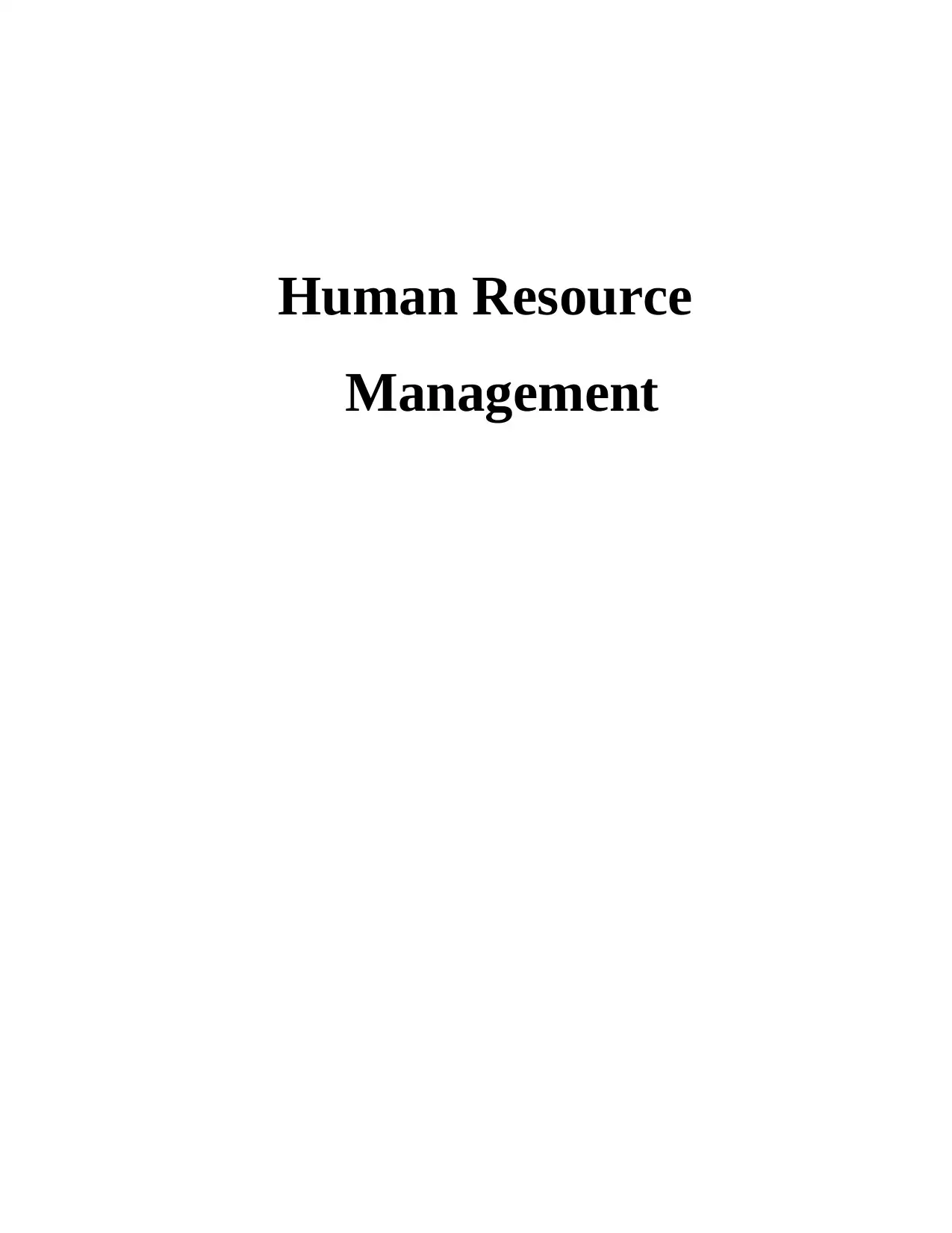
Human Resource
Management
Management
Paraphrase This Document
Need a fresh take? Get an instant paraphrase of this document with our AI Paraphraser
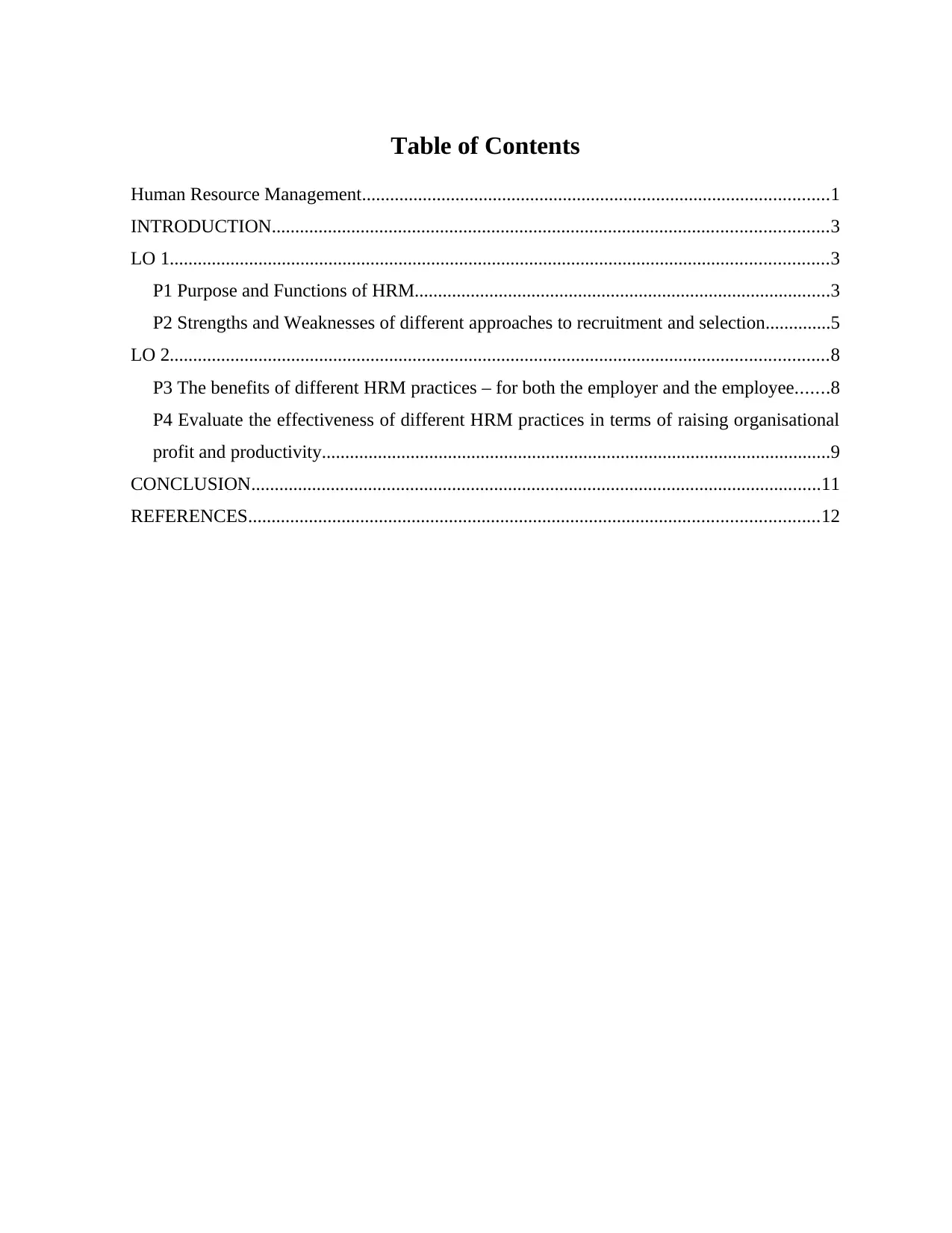
Table of Contents
Human Resource Management....................................................................................................1
INTRODUCTION.......................................................................................................................3
LO 1.............................................................................................................................................3
P1 Purpose and Functions of HRM.........................................................................................3
P2 Strengths and Weaknesses of different approaches to recruitment and selection..............5
LO 2.............................................................................................................................................8
P3 The benefits of different HRM practices – for both the employer and the employee.......8
P4 Evaluate the effectiveness of different HRM practices in terms of raising organisational
profit and productivity.............................................................................................................9
CONCLUSION..........................................................................................................................11
REFERENCES..........................................................................................................................12
Human Resource Management....................................................................................................1
INTRODUCTION.......................................................................................................................3
LO 1.............................................................................................................................................3
P1 Purpose and Functions of HRM.........................................................................................3
P2 Strengths and Weaknesses of different approaches to recruitment and selection..............5
LO 2.............................................................................................................................................8
P3 The benefits of different HRM practices – for both the employer and the employee.......8
P4 Evaluate the effectiveness of different HRM practices in terms of raising organisational
profit and productivity.............................................................................................................9
CONCLUSION..........................................................................................................................11
REFERENCES..........................................................................................................................12
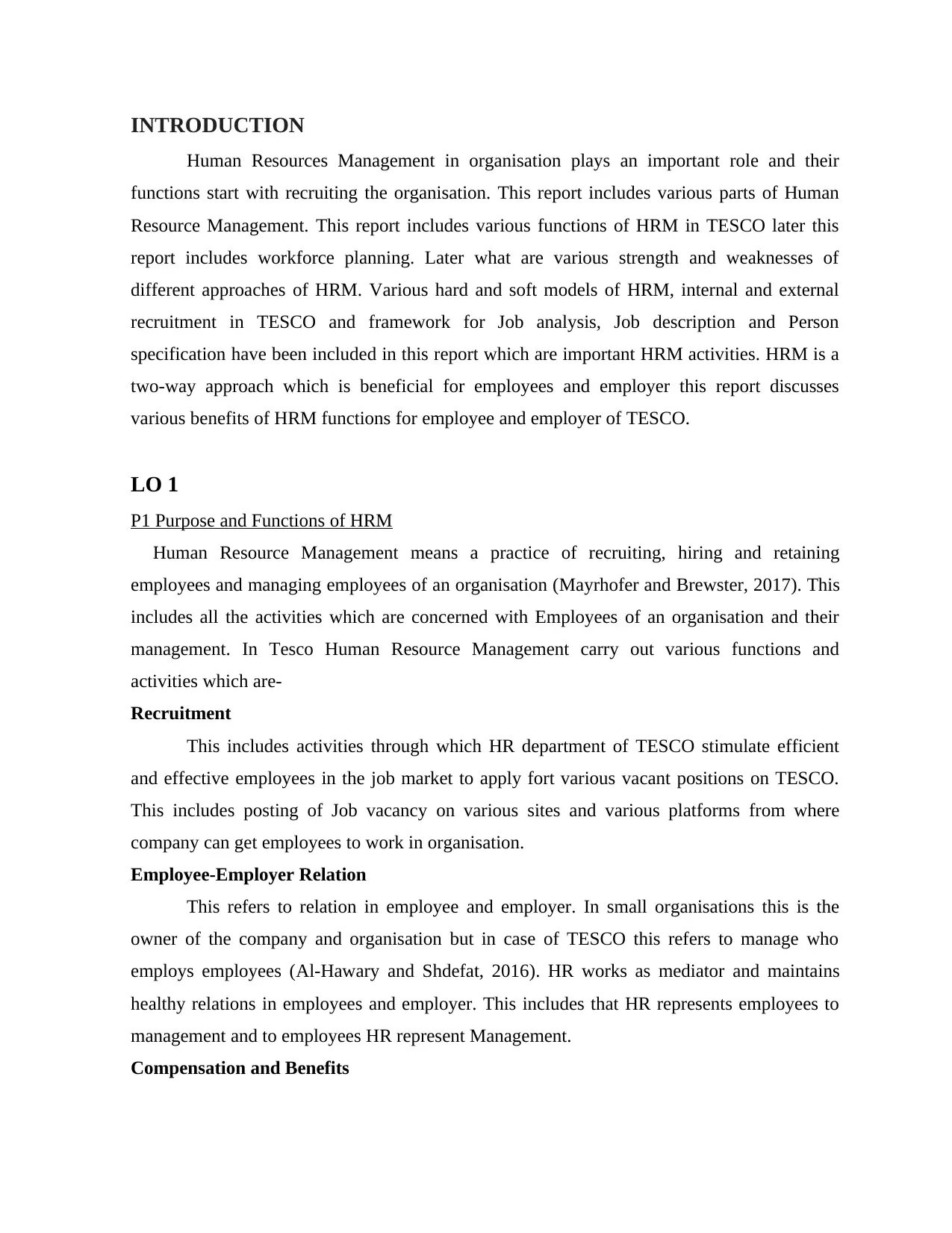
INTRODUCTION
Human Resources Management in organisation plays an important role and their
functions start with recruiting the organisation. This report includes various parts of Human
Resource Management. This report includes various functions of HRM in TESCO later this
report includes workforce planning. Later what are various strength and weaknesses of
different approaches of HRM. Various hard and soft models of HRM, internal and external
recruitment in TESCO and framework for Job analysis, Job description and Person
specification have been included in this report which are important HRM activities. HRM is a
two-way approach which is beneficial for employees and employer this report discusses
various benefits of HRM functions for employee and employer of TESCO.
LO 1
P1 Purpose and Functions of HRM
Human Resource Management means a practice of recruiting, hiring and retaining
employees and managing employees of an organisation (Mayrhofer and Brewster, 2017). This
includes all the activities which are concerned with Employees of an organisation and their
management. In Tesco Human Resource Management carry out various functions and
activities which are-
Recruitment
This includes activities through which HR department of TESCO stimulate efficient
and effective employees in the job market to apply fort various vacant positions on TESCO.
This includes posting of Job vacancy on various sites and various platforms from where
company can get employees to work in organisation.
Employee-Employer Relation
This refers to relation in employee and employer. In small organisations this is the
owner of the company and organisation but in case of TESCO this refers to manage who
employs employees (Al-Hawary and Shdefat, 2016). HR works as mediator and maintains
healthy relations in employees and employer. This includes that HR represents employees to
management and to employees HR represent Management.
Compensation and Benefits
Human Resources Management in organisation plays an important role and their
functions start with recruiting the organisation. This report includes various parts of Human
Resource Management. This report includes various functions of HRM in TESCO later this
report includes workforce planning. Later what are various strength and weaknesses of
different approaches of HRM. Various hard and soft models of HRM, internal and external
recruitment in TESCO and framework for Job analysis, Job description and Person
specification have been included in this report which are important HRM activities. HRM is a
two-way approach which is beneficial for employees and employer this report discusses
various benefits of HRM functions for employee and employer of TESCO.
LO 1
P1 Purpose and Functions of HRM
Human Resource Management means a practice of recruiting, hiring and retaining
employees and managing employees of an organisation (Mayrhofer and Brewster, 2017). This
includes all the activities which are concerned with Employees of an organisation and their
management. In Tesco Human Resource Management carry out various functions and
activities which are-
Recruitment
This includes activities through which HR department of TESCO stimulate efficient
and effective employees in the job market to apply fort various vacant positions on TESCO.
This includes posting of Job vacancy on various sites and various platforms from where
company can get employees to work in organisation.
Employee-Employer Relation
This refers to relation in employee and employer. In small organisations this is the
owner of the company and organisation but in case of TESCO this refers to manage who
employs employees (Al-Hawary and Shdefat, 2016). HR works as mediator and maintains
healthy relations in employees and employer. This includes that HR represents employees to
management and to employees HR represent Management.
Compensation and Benefits
⊘ This is a preview!⊘
Do you want full access?
Subscribe today to unlock all pages.

Trusted by 1+ million students worldwide
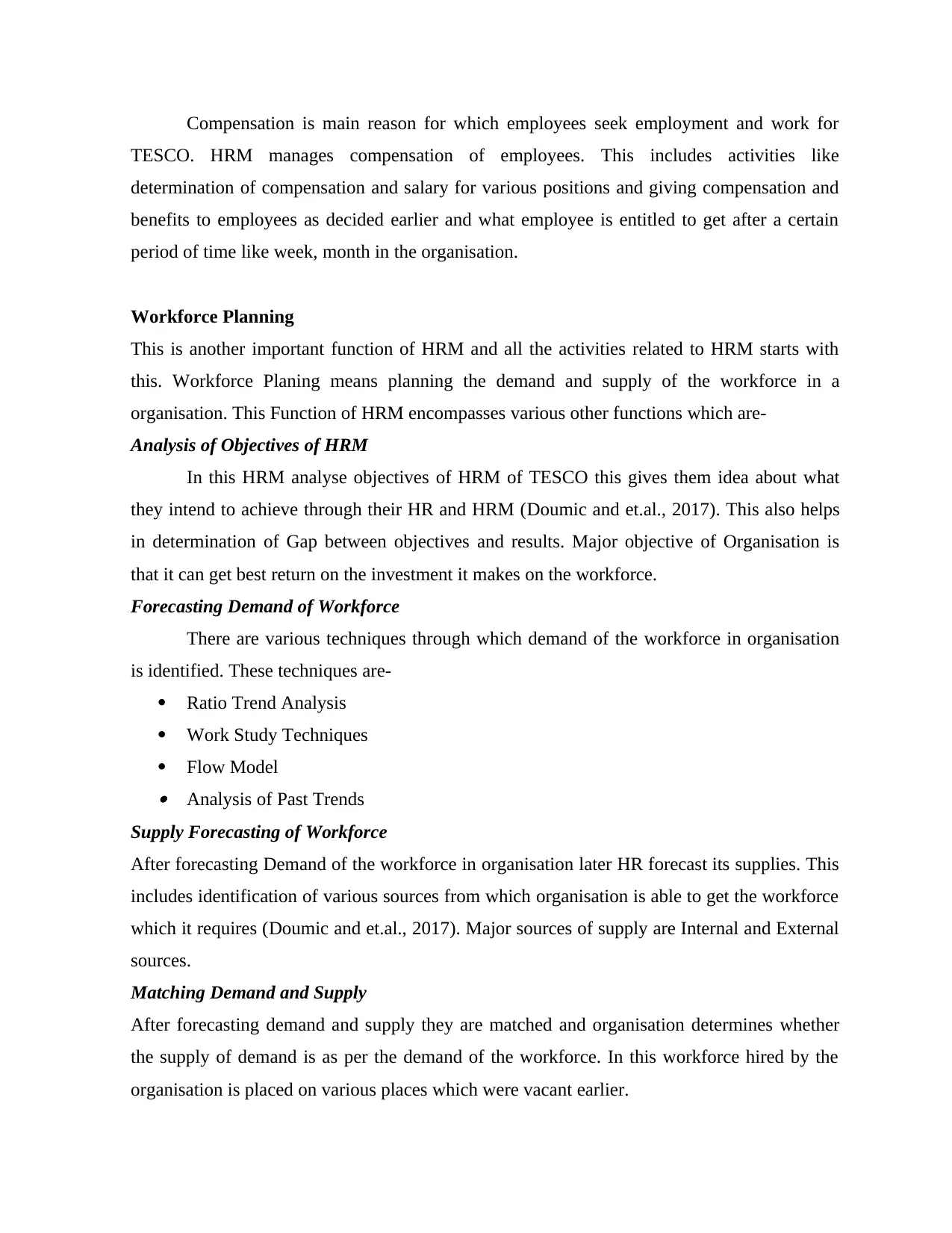
Compensation is main reason for which employees seek employment and work for
TESCO. HRM manages compensation of employees. This includes activities like
determination of compensation and salary for various positions and giving compensation and
benefits to employees as decided earlier and what employee is entitled to get after a certain
period of time like week, month in the organisation.
Workforce Planning
This is another important function of HRM and all the activities related to HRM starts with
this. Workforce Planing means planning the demand and supply of the workforce in a
organisation. This Function of HRM encompasses various other functions which are-
Analysis of Objectives of HRM
In this HRM analyse objectives of HRM of TESCO this gives them idea about what
they intend to achieve through their HR and HRM (Doumic and et.al., 2017). This also helps
in determination of Gap between objectives and results. Major objective of Organisation is
that it can get best return on the investment it makes on the workforce.
Forecasting Demand of Workforce
There are various techniques through which demand of the workforce in organisation
is identified. These techniques are-
Ratio Trend Analysis
Work Study Techniques
Flow Model
Analysis of Past Trends
Supply Forecasting of Workforce
After forecasting Demand of the workforce in organisation later HR forecast its supplies. This
includes identification of various sources from which organisation is able to get the workforce
which it requires (Doumic and et.al., 2017). Major sources of supply are Internal and External
sources.
Matching Demand and Supply
After forecasting demand and supply they are matched and organisation determines whether
the supply of demand is as per the demand of the workforce. In this workforce hired by the
organisation is placed on various places which were vacant earlier.
TESCO. HRM manages compensation of employees. This includes activities like
determination of compensation and salary for various positions and giving compensation and
benefits to employees as decided earlier and what employee is entitled to get after a certain
period of time like week, month in the organisation.
Workforce Planning
This is another important function of HRM and all the activities related to HRM starts with
this. Workforce Planing means planning the demand and supply of the workforce in a
organisation. This Function of HRM encompasses various other functions which are-
Analysis of Objectives of HRM
In this HRM analyse objectives of HRM of TESCO this gives them idea about what
they intend to achieve through their HR and HRM (Doumic and et.al., 2017). This also helps
in determination of Gap between objectives and results. Major objective of Organisation is
that it can get best return on the investment it makes on the workforce.
Forecasting Demand of Workforce
There are various techniques through which demand of the workforce in organisation
is identified. These techniques are-
Ratio Trend Analysis
Work Study Techniques
Flow Model
Analysis of Past Trends
Supply Forecasting of Workforce
After forecasting Demand of the workforce in organisation later HR forecast its supplies. This
includes identification of various sources from which organisation is able to get the workforce
which it requires (Doumic and et.al., 2017). Major sources of supply are Internal and External
sources.
Matching Demand and Supply
After forecasting demand and supply they are matched and organisation determines whether
the supply of demand is as per the demand of the workforce. In this workforce hired by the
organisation is placed on various places which were vacant earlier.
Paraphrase This Document
Need a fresh take? Get an instant paraphrase of this document with our AI Paraphraser
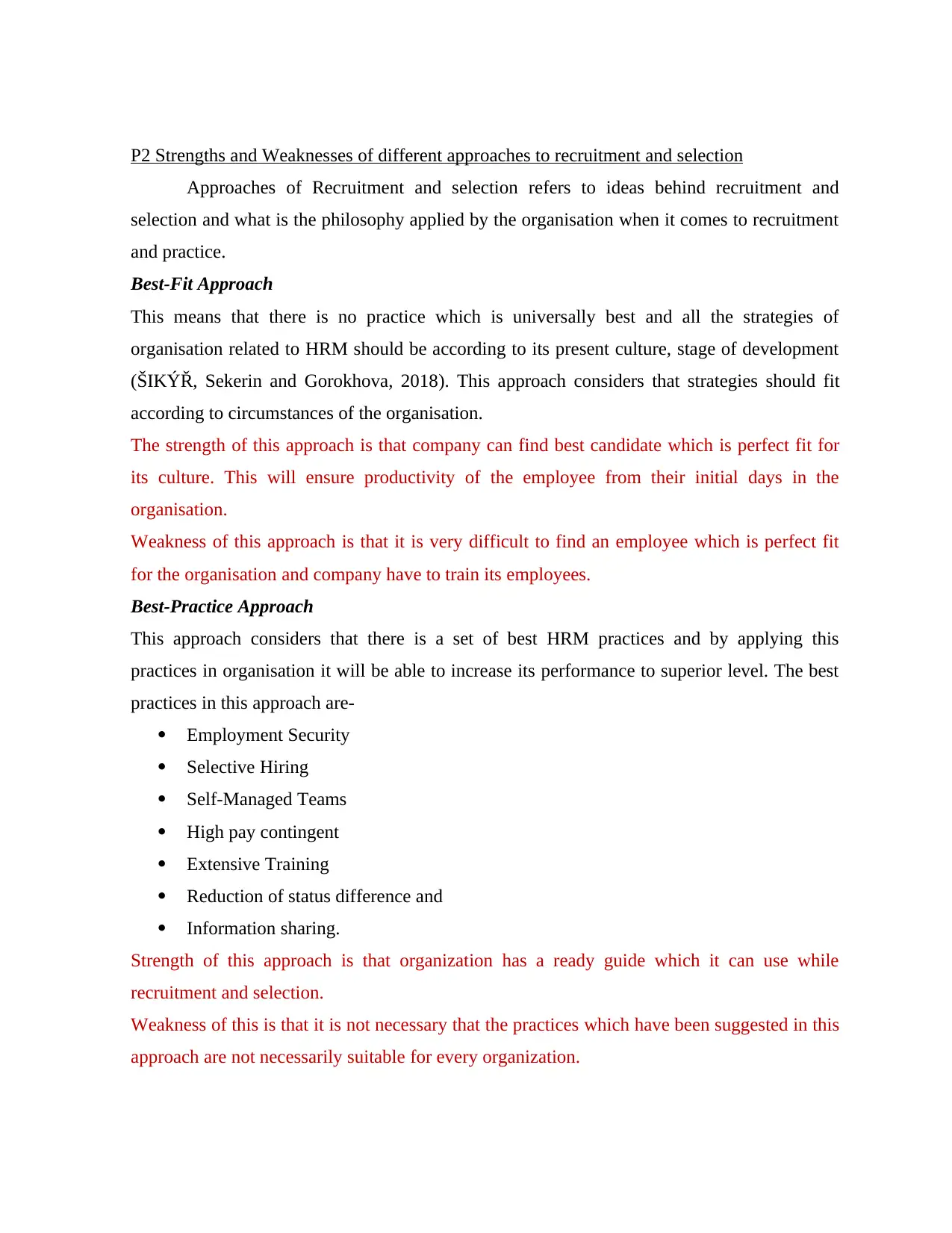
P2 Strengths and Weaknesses of different approaches to recruitment and selection
Approaches of Recruitment and selection refers to ideas behind recruitment and
selection and what is the philosophy applied by the organisation when it comes to recruitment
and practice.
Best-Fit Approach
This means that there is no practice which is universally best and all the strategies of
organisation related to HRM should be according to its present culture, stage of development
(ŠIKÝŘ, Sekerin and Gorokhova, 2018). This approach considers that strategies should fit
according to circumstances of the organisation.
The strength of this approach is that company can find best candidate which is perfect fit for
its culture. This will ensure productivity of the employee from their initial days in the
organisation.
Weakness of this approach is that it is very difficult to find an employee which is perfect fit
for the organisation and company have to train its employees.
Best-Practice Approach
This approach considers that there is a set of best HRM practices and by applying this
practices in organisation it will be able to increase its performance to superior level. The best
practices in this approach are-
Employment Security
Selective Hiring
Self-Managed Teams
High pay contingent
Extensive Training
Reduction of status difference and
Information sharing.
Strength of this approach is that organization has a ready guide which it can use while
recruitment and selection.
Weakness of this is that it is not necessary that the practices which have been suggested in this
approach are not necessarily suitable for every organization.
Approaches of Recruitment and selection refers to ideas behind recruitment and
selection and what is the philosophy applied by the organisation when it comes to recruitment
and practice.
Best-Fit Approach
This means that there is no practice which is universally best and all the strategies of
organisation related to HRM should be according to its present culture, stage of development
(ŠIKÝŘ, Sekerin and Gorokhova, 2018). This approach considers that strategies should fit
according to circumstances of the organisation.
The strength of this approach is that company can find best candidate which is perfect fit for
its culture. This will ensure productivity of the employee from their initial days in the
organisation.
Weakness of this approach is that it is very difficult to find an employee which is perfect fit
for the organisation and company have to train its employees.
Best-Practice Approach
This approach considers that there is a set of best HRM practices and by applying this
practices in organisation it will be able to increase its performance to superior level. The best
practices in this approach are-
Employment Security
Selective Hiring
Self-Managed Teams
High pay contingent
Extensive Training
Reduction of status difference and
Information sharing.
Strength of this approach is that organization has a ready guide which it can use while
recruitment and selection.
Weakness of this is that it is not necessary that the practices which have been suggested in this
approach are not necessarily suitable for every organization.
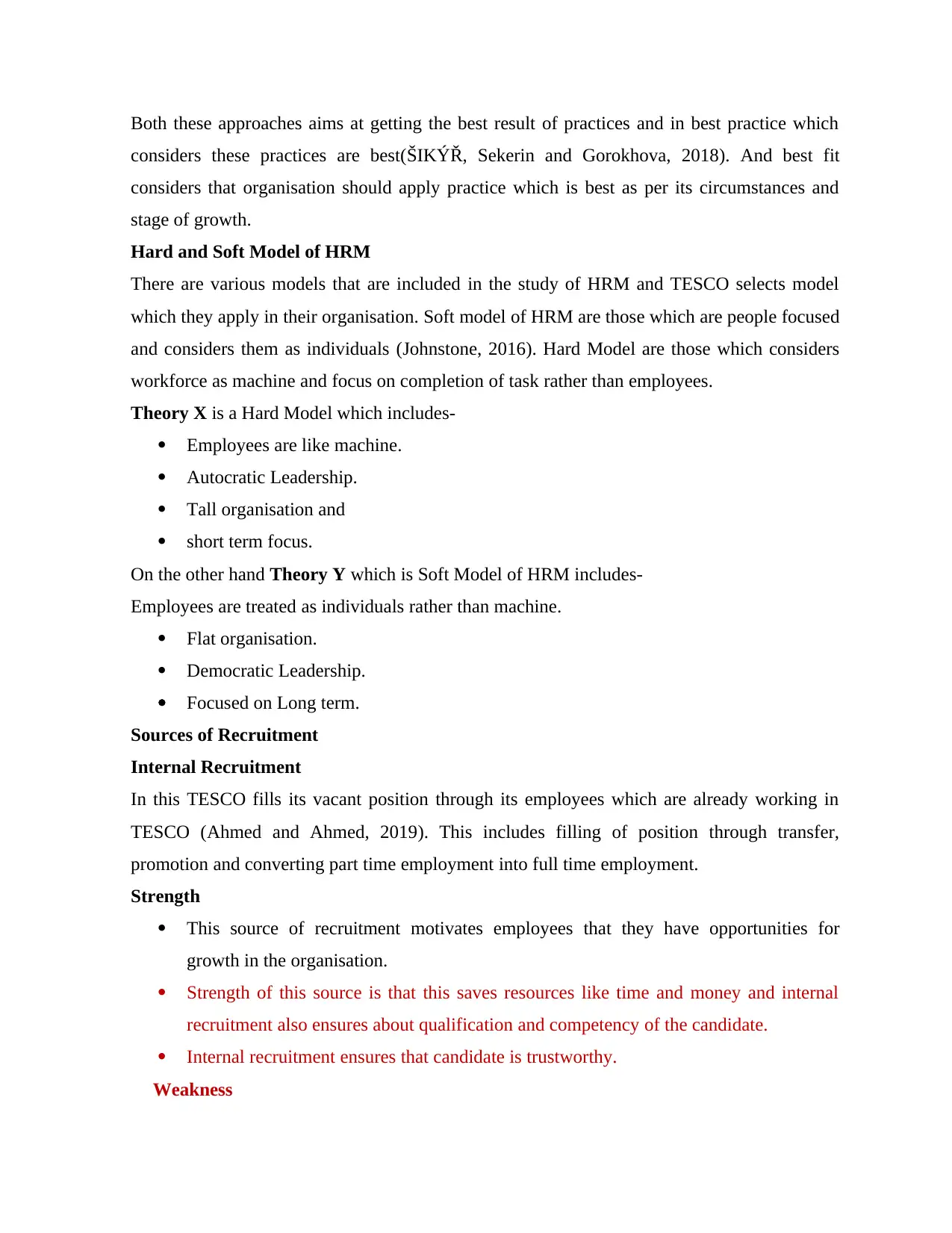
Both these approaches aims at getting the best result of practices and in best practice which
considers these practices are best(ŠIKÝŘ, Sekerin and Gorokhova, 2018). And best fit
considers that organisation should apply practice which is best as per its circumstances and
stage of growth.
Hard and Soft Model of HRM
There are various models that are included in the study of HRM and TESCO selects model
which they apply in their organisation. Soft model of HRM are those which are people focused
and considers them as individuals (Johnstone, 2016). Hard Model are those which considers
workforce as machine and focus on completion of task rather than employees.
Theory X is a Hard Model which includes-
Employees are like machine.
Autocratic Leadership.
Tall organisation and
short term focus.
On the other hand Theory Y which is Soft Model of HRM includes-
Employees are treated as individuals rather than machine.
Flat organisation.
Democratic Leadership.
Focused on Long term.
Sources of Recruitment
Internal Recruitment
In this TESCO fills its vacant position through its employees which are already working in
TESCO (Ahmed and Ahmed, 2019). This includes filling of position through transfer,
promotion and converting part time employment into full time employment.
Strength
This source of recruitment motivates employees that they have opportunities for
growth in the organisation.
Strength of this source is that this saves resources like time and money and internal
recruitment also ensures about qualification and competency of the candidate.
Internal recruitment ensures that candidate is trustworthy.
Weakness
considers these practices are best(ŠIKÝŘ, Sekerin and Gorokhova, 2018). And best fit
considers that organisation should apply practice which is best as per its circumstances and
stage of growth.
Hard and Soft Model of HRM
There are various models that are included in the study of HRM and TESCO selects model
which they apply in their organisation. Soft model of HRM are those which are people focused
and considers them as individuals (Johnstone, 2016). Hard Model are those which considers
workforce as machine and focus on completion of task rather than employees.
Theory X is a Hard Model which includes-
Employees are like machine.
Autocratic Leadership.
Tall organisation and
short term focus.
On the other hand Theory Y which is Soft Model of HRM includes-
Employees are treated as individuals rather than machine.
Flat organisation.
Democratic Leadership.
Focused on Long term.
Sources of Recruitment
Internal Recruitment
In this TESCO fills its vacant position through its employees which are already working in
TESCO (Ahmed and Ahmed, 2019). This includes filling of position through transfer,
promotion and converting part time employment into full time employment.
Strength
This source of recruitment motivates employees that they have opportunities for
growth in the organisation.
Strength of this source is that this saves resources like time and money and internal
recruitment also ensures about qualification and competency of the candidate.
Internal recruitment ensures that candidate is trustworthy.
Weakness
⊘ This is a preview!⊘
Do you want full access?
Subscribe today to unlock all pages.

Trusted by 1+ million students worldwide
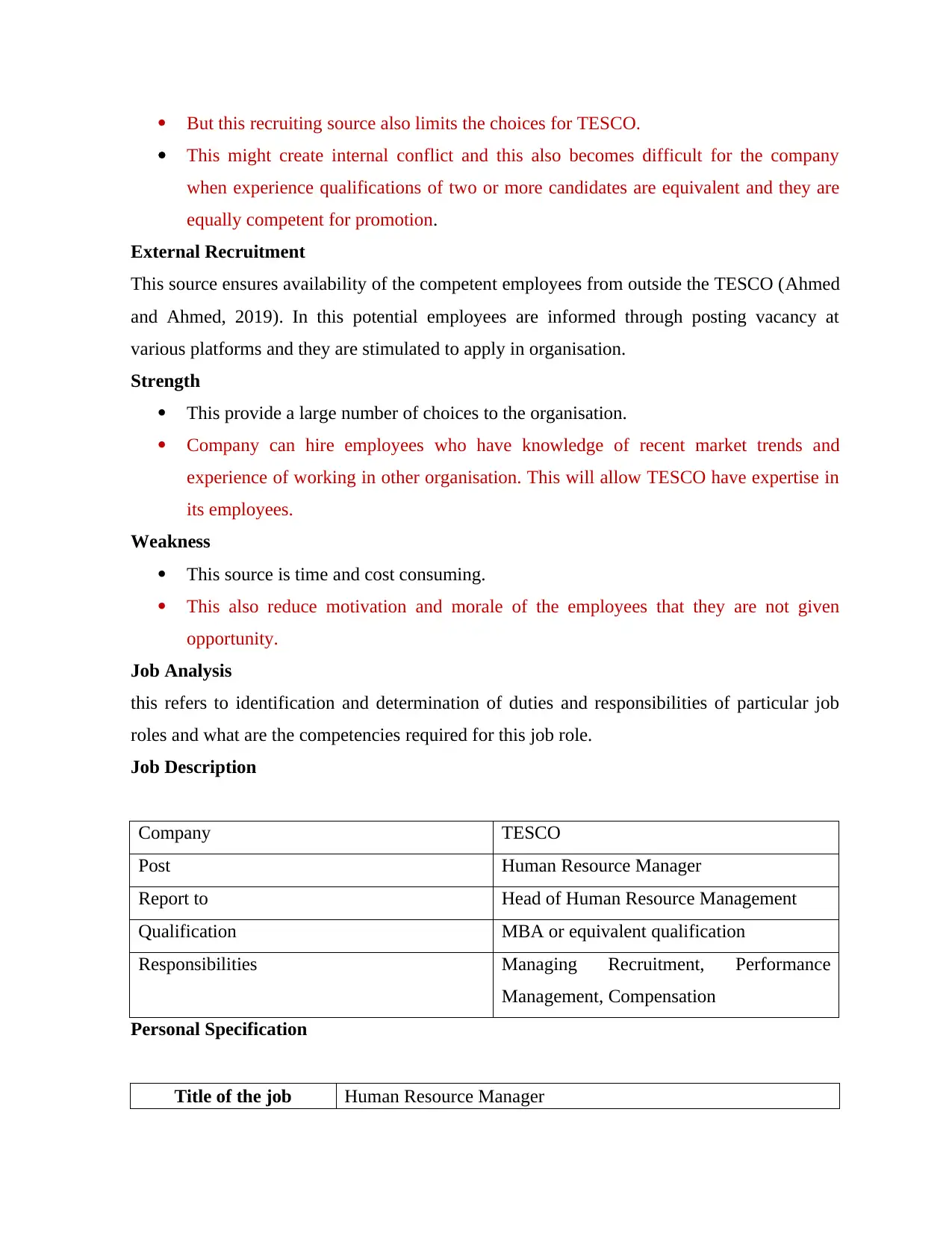
But this recruiting source also limits the choices for TESCO.
This might create internal conflict and this also becomes difficult for the company
when experience qualifications of two or more candidates are equivalent and they are
equally competent for promotion.
External Recruitment
This source ensures availability of the competent employees from outside the TESCO (Ahmed
and Ahmed, 2019). In this potential employees are informed through posting vacancy at
various platforms and they are stimulated to apply in organisation.
Strength
This provide a large number of choices to the organisation.
Company can hire employees who have knowledge of recent market trends and
experience of working in other organisation. This will allow TESCO have expertise in
its employees.
Weakness
This source is time and cost consuming.
This also reduce motivation and morale of the employees that they are not given
opportunity.
Job Analysis
this refers to identification and determination of duties and responsibilities of particular job
roles and what are the competencies required for this job role.
Job Description
Company TESCO
Post Human Resource Manager
Report to Head of Human Resource Management
Qualification MBA or equivalent qualification
Responsibilities Managing Recruitment, Performance
Management, Compensation
Personal Specification
Title of the job Human Resource Manager
This might create internal conflict and this also becomes difficult for the company
when experience qualifications of two or more candidates are equivalent and they are
equally competent for promotion.
External Recruitment
This source ensures availability of the competent employees from outside the TESCO (Ahmed
and Ahmed, 2019). In this potential employees are informed through posting vacancy at
various platforms and they are stimulated to apply in organisation.
Strength
This provide a large number of choices to the organisation.
Company can hire employees who have knowledge of recent market trends and
experience of working in other organisation. This will allow TESCO have expertise in
its employees.
Weakness
This source is time and cost consuming.
This also reduce motivation and morale of the employees that they are not given
opportunity.
Job Analysis
this refers to identification and determination of duties and responsibilities of particular job
roles and what are the competencies required for this job role.
Job Description
Company TESCO
Post Human Resource Manager
Report to Head of Human Resource Management
Qualification MBA or equivalent qualification
Responsibilities Managing Recruitment, Performance
Management, Compensation
Personal Specification
Title of the job Human Resource Manager
Paraphrase This Document
Need a fresh take? Get an instant paraphrase of this document with our AI Paraphraser
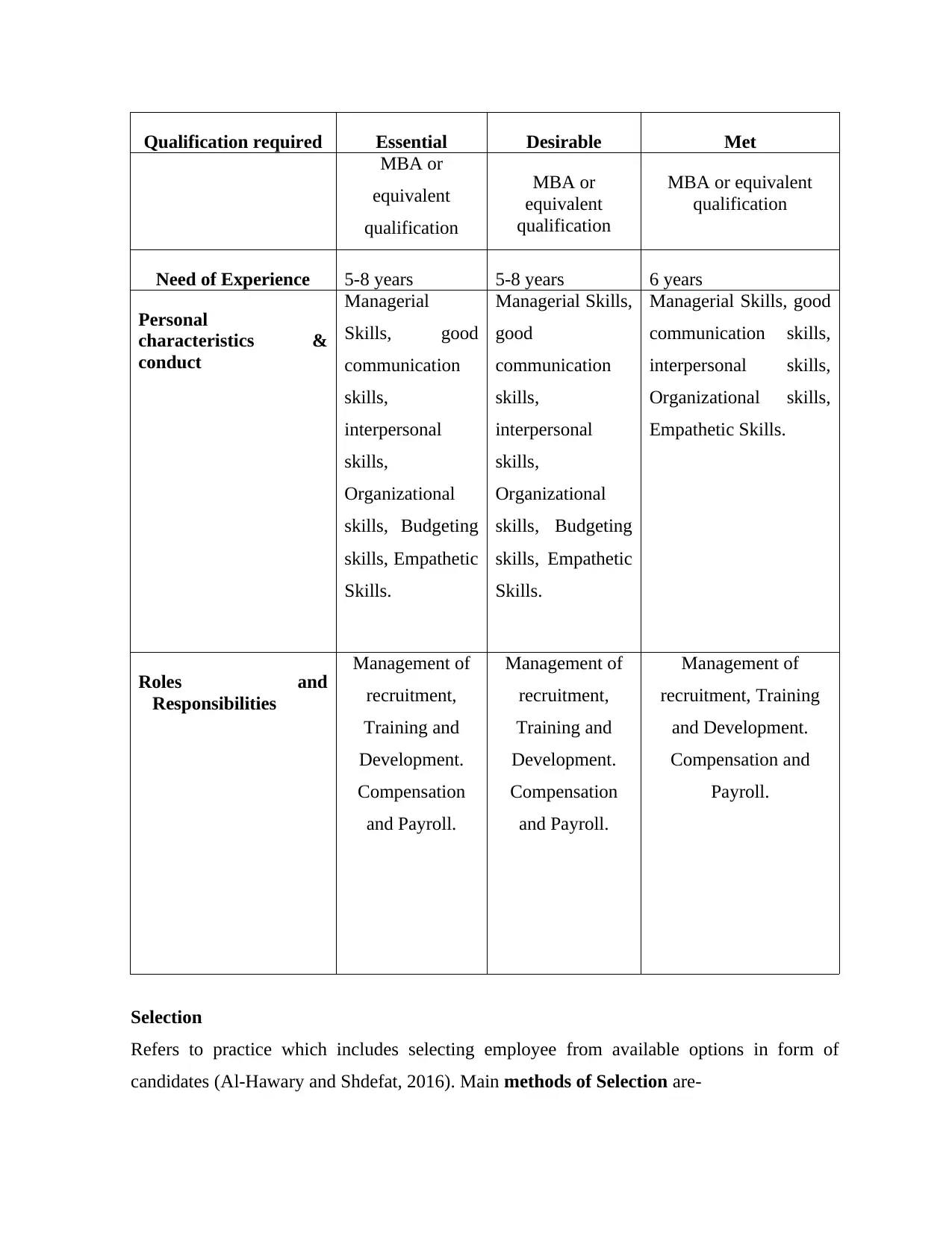
Qualification required Essential Desirable Met
MBA or
equivalent
qualification
MBA or
equivalent
qualification
MBA or equivalent
qualification
Need of Experience 5-8 years 5-8 years 6 years
Personal
characteristics &
conduct
Managerial
Skills, good
communication
skills,
interpersonal
skills,
Organizational
skills, Budgeting
skills, Empathetic
Skills.
Managerial Skills,
good
communication
skills,
interpersonal
skills,
Organizational
skills, Budgeting
skills, Empathetic
Skills.
Managerial Skills, good
communication skills,
interpersonal skills,
Organizational skills,
Empathetic Skills.
Roles and
Responsibilities
Management of
recruitment,
Training and
Development.
Compensation
and Payroll.
Management of
recruitment,
Training and
Development.
Compensation
and Payroll.
Management of
recruitment, Training
and Development.
Compensation and
Payroll.
Selection
Refers to practice which includes selecting employee from available options in form of
candidates (Al-Hawary and Shdefat, 2016). Main methods of Selection are-
MBA or
equivalent
qualification
MBA or
equivalent
qualification
MBA or equivalent
qualification
Need of Experience 5-8 years 5-8 years 6 years
Personal
characteristics &
conduct
Managerial
Skills, good
communication
skills,
interpersonal
skills,
Organizational
skills, Budgeting
skills, Empathetic
Skills.
Managerial Skills,
good
communication
skills,
interpersonal
skills,
Organizational
skills, Budgeting
skills, Empathetic
Skills.
Managerial Skills, good
communication skills,
interpersonal skills,
Organizational skills,
Empathetic Skills.
Roles and
Responsibilities
Management of
recruitment,
Training and
Development.
Compensation
and Payroll.
Management of
recruitment,
Training and
Development.
Compensation
and Payroll.
Management of
recruitment, Training
and Development.
Compensation and
Payroll.
Selection
Refers to practice which includes selecting employee from available options in form of
candidates (Al-Hawary and Shdefat, 2016). Main methods of Selection are-
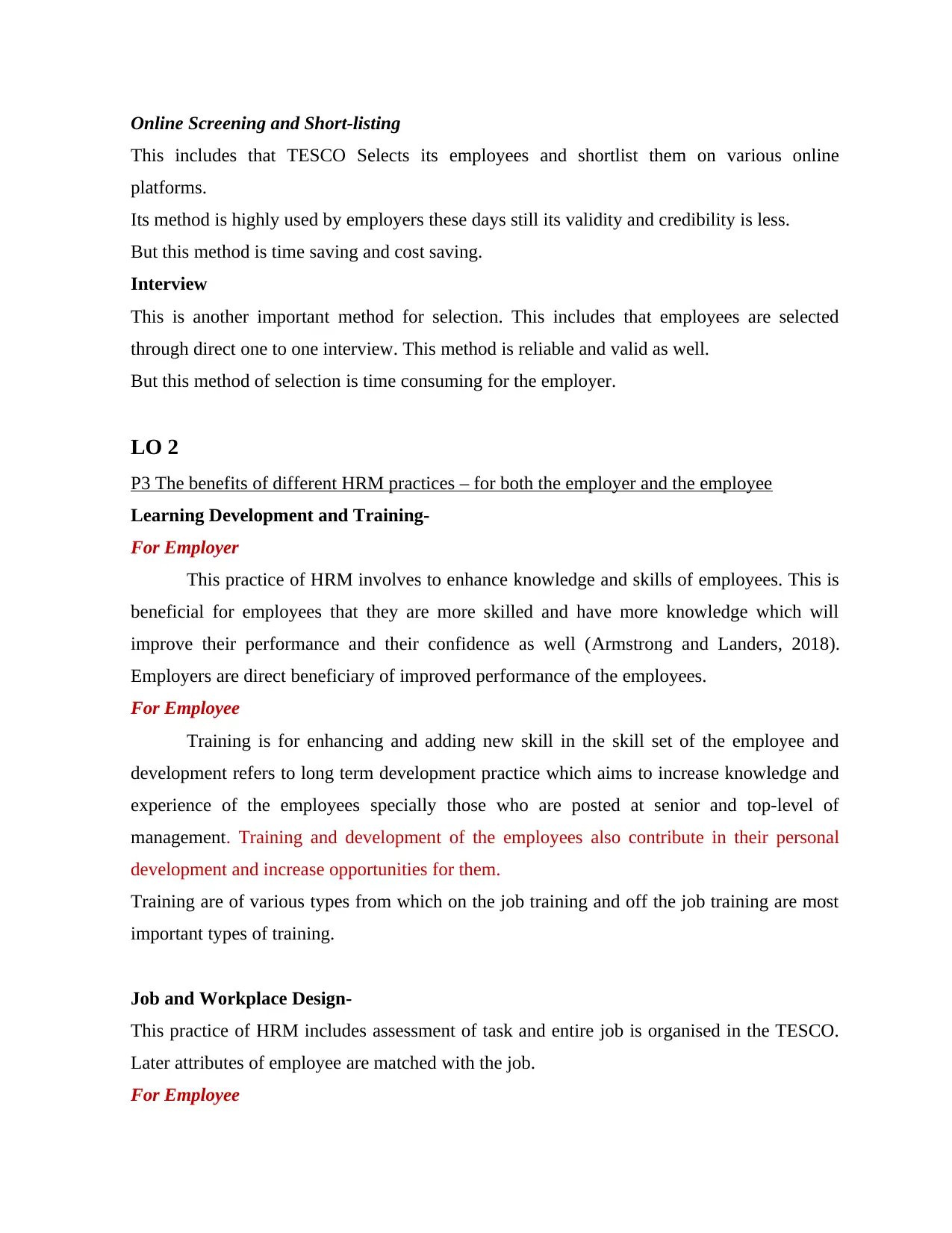
Online Screening and Short-listing
This includes that TESCO Selects its employees and shortlist them on various online
platforms.
Its method is highly used by employers these days still its validity and credibility is less.
But this method is time saving and cost saving.
Interview
This is another important method for selection. This includes that employees are selected
through direct one to one interview. This method is reliable and valid as well.
But this method of selection is time consuming for the employer.
LO 2
P3 The benefits of different HRM practices – for both the employer and the employee
Learning Development and Training-
For Employer
This practice of HRM involves to enhance knowledge and skills of employees. This is
beneficial for employees that they are more skilled and have more knowledge which will
improve their performance and their confidence as well (Armstrong and Landers, 2018).
Employers are direct beneficiary of improved performance of the employees.
For Employee
Training is for enhancing and adding new skill in the skill set of the employee and
development refers to long term development practice which aims to increase knowledge and
experience of the employees specially those who are posted at senior and top-level of
management. Training and development of the employees also contribute in their personal
development and increase opportunities for them.
Training are of various types from which on the job training and off the job training are most
important types of training.
Job and Workplace Design-
This practice of HRM includes assessment of task and entire job is organised in the TESCO.
Later attributes of employee are matched with the job.
For Employee
This includes that TESCO Selects its employees and shortlist them on various online
platforms.
Its method is highly used by employers these days still its validity and credibility is less.
But this method is time saving and cost saving.
Interview
This is another important method for selection. This includes that employees are selected
through direct one to one interview. This method is reliable and valid as well.
But this method of selection is time consuming for the employer.
LO 2
P3 The benefits of different HRM practices – for both the employer and the employee
Learning Development and Training-
For Employer
This practice of HRM involves to enhance knowledge and skills of employees. This is
beneficial for employees that they are more skilled and have more knowledge which will
improve their performance and their confidence as well (Armstrong and Landers, 2018).
Employers are direct beneficiary of improved performance of the employees.
For Employee
Training is for enhancing and adding new skill in the skill set of the employee and
development refers to long term development practice which aims to increase knowledge and
experience of the employees specially those who are posted at senior and top-level of
management. Training and development of the employees also contribute in their personal
development and increase opportunities for them.
Training are of various types from which on the job training and off the job training are most
important types of training.
Job and Workplace Design-
This practice of HRM includes assessment of task and entire job is organised in the TESCO.
Later attributes of employee are matched with the job.
For Employee
⊘ This is a preview!⊘
Do you want full access?
Subscribe today to unlock all pages.

Trusted by 1+ million students worldwide
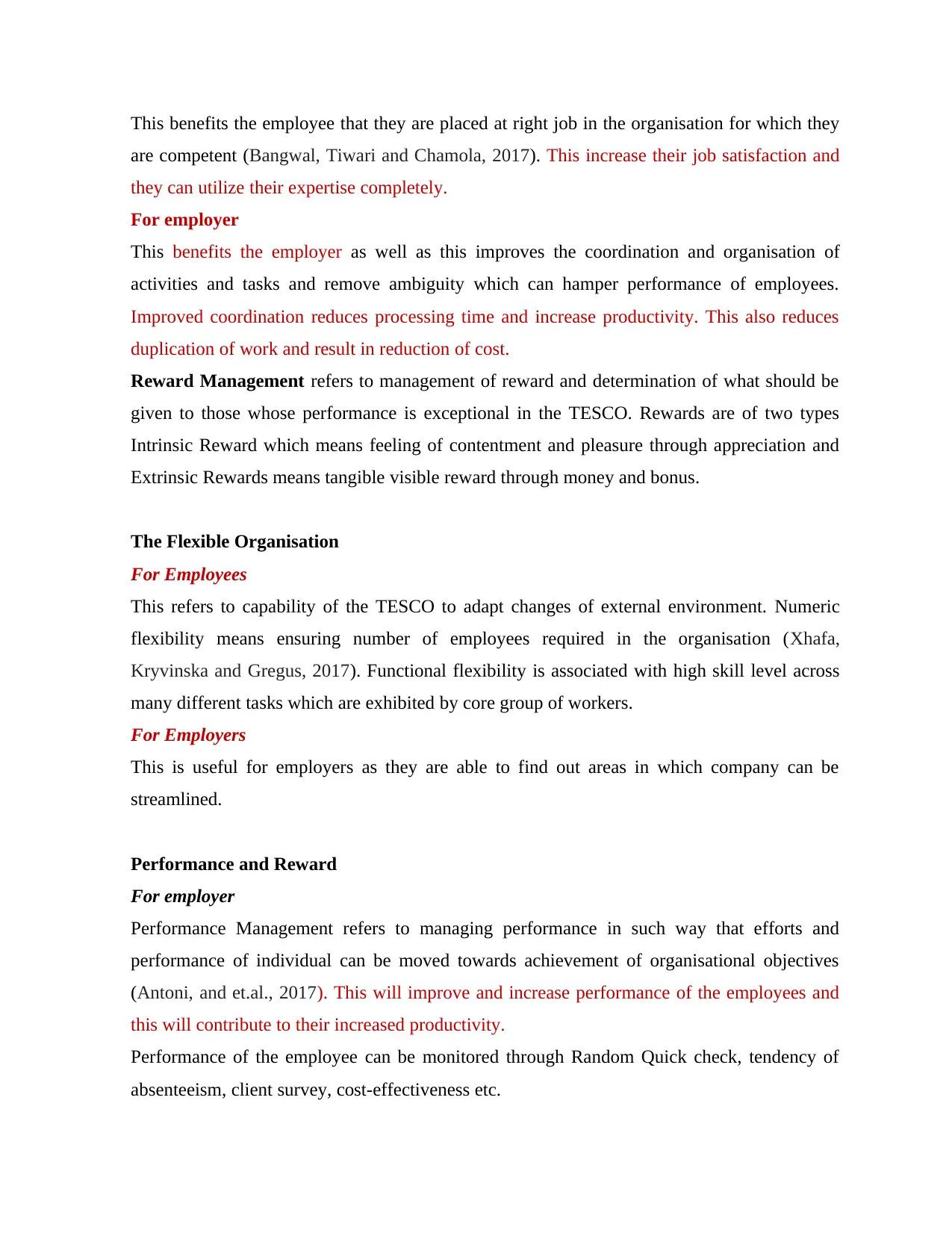
This benefits the employee that they are placed at right job in the organisation for which they
are competent (Bangwal, Tiwari and Chamola, 2017). This increase their job satisfaction and
they can utilize their expertise completely.
For employer
This benefits the employer as well as this improves the coordination and organisation of
activities and tasks and remove ambiguity which can hamper performance of employees.
Improved coordination reduces processing time and increase productivity. This also reduces
duplication of work and result in reduction of cost.
Reward Management refers to management of reward and determination of what should be
given to those whose performance is exceptional in the TESCO. Rewards are of two types
Intrinsic Reward which means feeling of contentment and pleasure through appreciation and
Extrinsic Rewards means tangible visible reward through money and bonus.
The Flexible Organisation
For Employees
This refers to capability of the TESCO to adapt changes of external environment. Numeric
flexibility means ensuring number of employees required in the organisation (Xhafa,
Kryvinska and Gregus, 2017). Functional flexibility is associated with high skill level across
many different tasks which are exhibited by core group of workers.
For Employers
This is useful for employers as they are able to find out areas in which company can be
streamlined.
Performance and Reward
For employer
Performance Management refers to managing performance in such way that efforts and
performance of individual can be moved towards achievement of organisational objectives
(Antoni, and et.al., 2017). This will improve and increase performance of the employees and
this will contribute to their increased productivity.
Performance of the employee can be monitored through Random Quick check, tendency of
absenteeism, client survey, cost-effectiveness etc.
are competent (Bangwal, Tiwari and Chamola, 2017). This increase their job satisfaction and
they can utilize their expertise completely.
For employer
This benefits the employer as well as this improves the coordination and organisation of
activities and tasks and remove ambiguity which can hamper performance of employees.
Improved coordination reduces processing time and increase productivity. This also reduces
duplication of work and result in reduction of cost.
Reward Management refers to management of reward and determination of what should be
given to those whose performance is exceptional in the TESCO. Rewards are of two types
Intrinsic Reward which means feeling of contentment and pleasure through appreciation and
Extrinsic Rewards means tangible visible reward through money and bonus.
The Flexible Organisation
For Employees
This refers to capability of the TESCO to adapt changes of external environment. Numeric
flexibility means ensuring number of employees required in the organisation (Xhafa,
Kryvinska and Gregus, 2017). Functional flexibility is associated with high skill level across
many different tasks which are exhibited by core group of workers.
For Employers
This is useful for employers as they are able to find out areas in which company can be
streamlined.
Performance and Reward
For employer
Performance Management refers to managing performance in such way that efforts and
performance of individual can be moved towards achievement of organisational objectives
(Antoni, and et.al., 2017). This will improve and increase performance of the employees and
this will contribute to their increased productivity.
Performance of the employee can be monitored through Random Quick check, tendency of
absenteeism, client survey, cost-effectiveness etc.
Paraphrase This Document
Need a fresh take? Get an instant paraphrase of this document with our AI Paraphraser
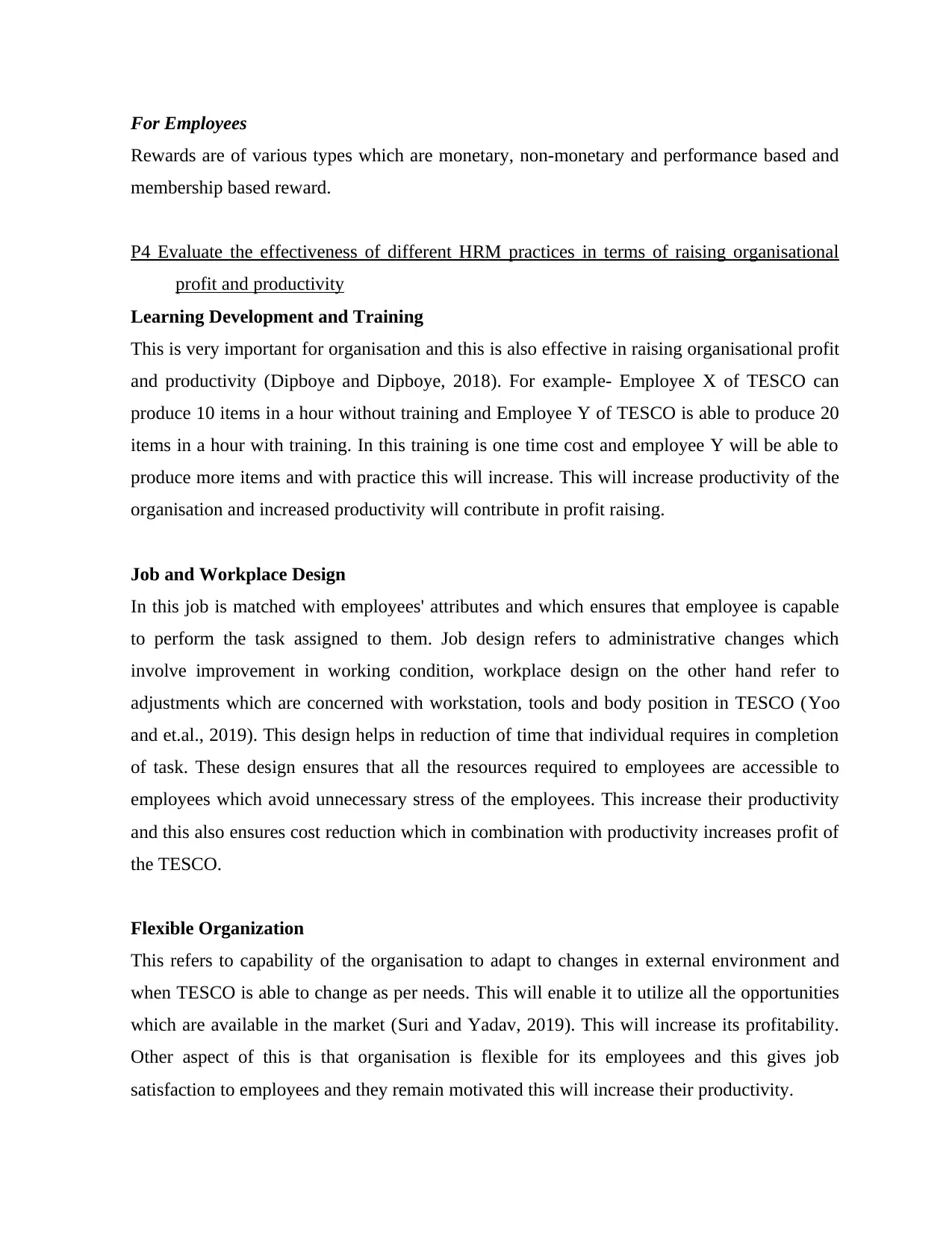
For Employees
Rewards are of various types which are monetary, non-monetary and performance based and
membership based reward.
P4 Evaluate the effectiveness of different HRM practices in terms of raising organisational
profit and productivity
Learning Development and Training
This is very important for organisation and this is also effective in raising organisational profit
and productivity (Dipboye and Dipboye, 2018). For example- Employee X of TESCO can
produce 10 items in a hour without training and Employee Y of TESCO is able to produce 20
items in a hour with training. In this training is one time cost and employee Y will be able to
produce more items and with practice this will increase. This will increase productivity of the
organisation and increased productivity will contribute in profit raising.
Job and Workplace Design
In this job is matched with employees' attributes and which ensures that employee is capable
to perform the task assigned to them. Job design refers to administrative changes which
involve improvement in working condition, workplace design on the other hand refer to
adjustments which are concerned with workstation, tools and body position in TESCO (Yoo
and et.al., 2019). This design helps in reduction of time that individual requires in completion
of task. These design ensures that all the resources required to employees are accessible to
employees which avoid unnecessary stress of the employees. This increase their productivity
and this also ensures cost reduction which in combination with productivity increases profit of
the TESCO.
Flexible Organization
This refers to capability of the organisation to adapt to changes in external environment and
when TESCO is able to change as per needs. This will enable it to utilize all the opportunities
which are available in the market (Suri and Yadav, 2019). This will increase its profitability.
Other aspect of this is that organisation is flexible for its employees and this gives job
satisfaction to employees and they remain motivated this will increase their productivity.
Rewards are of various types which are monetary, non-monetary and performance based and
membership based reward.
P4 Evaluate the effectiveness of different HRM practices in terms of raising organisational
profit and productivity
Learning Development and Training
This is very important for organisation and this is also effective in raising organisational profit
and productivity (Dipboye and Dipboye, 2018). For example- Employee X of TESCO can
produce 10 items in a hour without training and Employee Y of TESCO is able to produce 20
items in a hour with training. In this training is one time cost and employee Y will be able to
produce more items and with practice this will increase. This will increase productivity of the
organisation and increased productivity will contribute in profit raising.
Job and Workplace Design
In this job is matched with employees' attributes and which ensures that employee is capable
to perform the task assigned to them. Job design refers to administrative changes which
involve improvement in working condition, workplace design on the other hand refer to
adjustments which are concerned with workstation, tools and body position in TESCO (Yoo
and et.al., 2019). This design helps in reduction of time that individual requires in completion
of task. These design ensures that all the resources required to employees are accessible to
employees which avoid unnecessary stress of the employees. This increase their productivity
and this also ensures cost reduction which in combination with productivity increases profit of
the TESCO.
Flexible Organization
This refers to capability of the organisation to adapt to changes in external environment and
when TESCO is able to change as per needs. This will enable it to utilize all the opportunities
which are available in the market (Suri and Yadav, 2019). This will increase its profitability.
Other aspect of this is that organisation is flexible for its employees and this gives job
satisfaction to employees and they remain motivated this will increase their productivity.
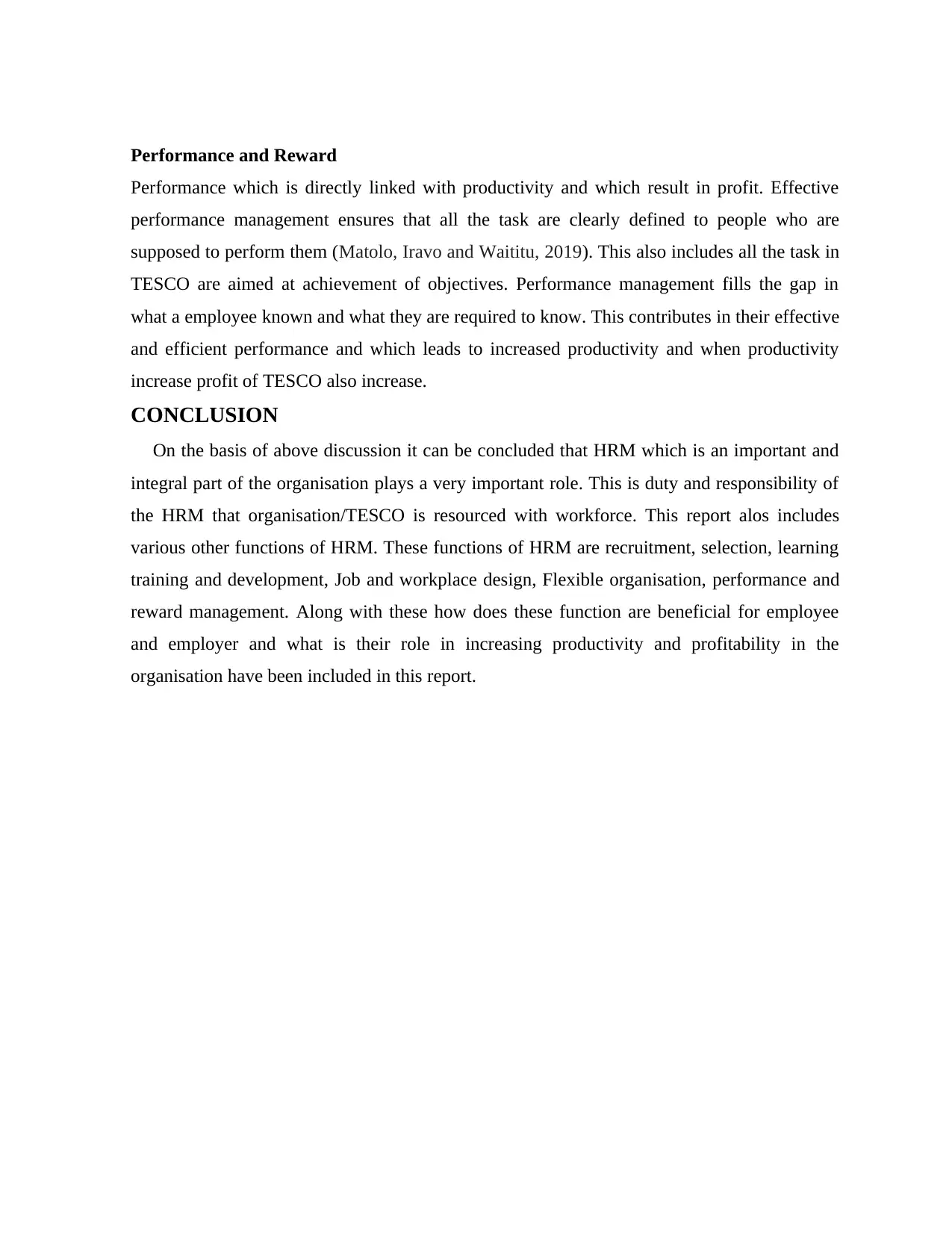
Performance and Reward
Performance which is directly linked with productivity and which result in profit. Effective
performance management ensures that all the task are clearly defined to people who are
supposed to perform them (Matolo, Iravo and Waititu, 2019). This also includes all the task in
TESCO are aimed at achievement of objectives. Performance management fills the gap in
what a employee known and what they are required to know. This contributes in their effective
and efficient performance and which leads to increased productivity and when productivity
increase profit of TESCO also increase.
CONCLUSION
On the basis of above discussion it can be concluded that HRM which is an important and
integral part of the organisation plays a very important role. This is duty and responsibility of
the HRM that organisation/TESCO is resourced with workforce. This report alos includes
various other functions of HRM. These functions of HRM are recruitment, selection, learning
training and development, Job and workplace design, Flexible organisation, performance and
reward management. Along with these how does these function are beneficial for employee
and employer and what is their role in increasing productivity and profitability in the
organisation have been included in this report.
Performance which is directly linked with productivity and which result in profit. Effective
performance management ensures that all the task are clearly defined to people who are
supposed to perform them (Matolo, Iravo and Waititu, 2019). This also includes all the task in
TESCO are aimed at achievement of objectives. Performance management fills the gap in
what a employee known and what they are required to know. This contributes in their effective
and efficient performance and which leads to increased productivity and when productivity
increase profit of TESCO also increase.
CONCLUSION
On the basis of above discussion it can be concluded that HRM which is an important and
integral part of the organisation plays a very important role. This is duty and responsibility of
the HRM that organisation/TESCO is resourced with workforce. This report alos includes
various other functions of HRM. These functions of HRM are recruitment, selection, learning
training and development, Job and workplace design, Flexible organisation, performance and
reward management. Along with these how does these function are beneficial for employee
and employer and what is their role in increasing productivity and profitability in the
organisation have been included in this report.
⊘ This is a preview!⊘
Do you want full access?
Subscribe today to unlock all pages.

Trusted by 1+ million students worldwide
1 out of 13
Related Documents
Your All-in-One AI-Powered Toolkit for Academic Success.
+13062052269
info@desklib.com
Available 24*7 on WhatsApp / Email
![[object Object]](/_next/static/media/star-bottom.7253800d.svg)
Unlock your academic potential
Copyright © 2020–2025 A2Z Services. All Rights Reserved. Developed and managed by ZUCOL.





